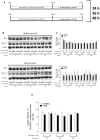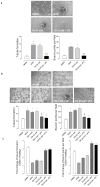Downregulation of the Netrin-1 Receptor UNC5b Underlies Increased Placental Angiogenesis in Human Gestational Diabetes Mellitus
- PMID: 30897795
- PMCID: PMC6470495
- DOI: 10.3390/ijms20061408
Downregulation of the Netrin-1 Receptor UNC5b Underlies Increased Placental Angiogenesis in Human Gestational Diabetes Mellitus
Abstract
Gestational diabetes mellitus (GDM) is a common metabolic disorder, defined by high blood glucose levels during pregnancy, which affects foetal and post-natal development. However, the cellular and molecular mechanisms of this detrimental condition are still poorly understood. A dysregulation in circulating angiogenic trophic factors, due to a dysfunction of the feto-placental unit, has been proposed to underlie GDM. But even the detailed study of canonical pro-angiogenic factors like vascular endothelial growth factor (VEGF) or basic Fibroblast Growth Factor (bFGF) has not been able to fully explain this detrimental condition during pregnancy. Netrins are non-canonical angiogenic ligands produced by the stroma have shown to be important in placental angiogenesis. In order to address the potential role of Netrin signalling in GDM, we tested the effect of Netrin-1, the most investigated member of the family, produced by Wharton's Jelly Mesenchymal Stem Cells (WJ-MSC), on Human Umbilical Vein Endothelial Cells (HUVEC) angiogenesis. WJ-MSC and HUVEC primary cell cultures from either healthy or GDM pregnancies were exposed to physiological (5 mM) or high (25 mM) d-glucose. Our results reveal that Netrin-1 is secreted by WJ-MSC from healthy and GDM and both expression and secretion of the ligand do not change with distinct experimental glucose conditions. Noteworthy, the expression of its anti-angiogenic receptor UNC5b is reduced in GDM HUVEC compared with its expression in healthy HUVEC, accounting for an increased Netrin-1 signalling in these cells. Consistently, in healthy HUVEC, UNC5b overexpression induces cell retraction of the sprouting phenotype.
Keywords: GDM; HUVEC; Netrin-1; UNC5b; WJ-MSC; angiogenesis.
Conflict of interest statement
The authors declare that they have no competing financial interests of other conflicts in relation to the work described in this paper.
Figures





Similar articles
-
Netrin-1 acts as a non-canonical angiogenic factor produced by human Wharton's jelly mesenchymal stem cells (WJ-MSC).Stem Cell Res Ther. 2017 Feb 28;8(1):43. doi: 10.1186/s13287-017-0494-5. Stem Cell Res Ther. 2017. PMID: 28241866 Free PMC article.
-
Gestational diabetes mellitus is associated with increased pro-migratory activation of vascular endothelial growth factor receptor 2 and reduced expression of vascular endothelial growth factor receptor 1.PLoS One. 2017 Aug 17;12(8):e0182509. doi: 10.1371/journal.pone.0182509. eCollection 2017. PLoS One. 2017. PMID: 28817576 Free PMC article.
-
Netrin-1 restores cell injury and impaired angiogenesis in vascular endothelial cells upon high glucose by PI3K/AKT-eNOS.J Mol Endocrinol. 2017 May;58(4):167-177. doi: 10.1530/JME-16-0239. Epub 2017 Mar 1. J Mol Endocrinol. 2017. PMID: 28250059
-
Netrin-1 role in angiogenesis: to be or not to be a pro-angiogenic factor?Cell Cycle. 2010 Apr 15;9(8):1466-71. doi: 10.4161/cc.9.8.11197. Epub 2010 Apr 15. Cell Cycle. 2010. PMID: 20372055 Review.
-
Netrins and their roles in placental angiogenesis.Biomed Res Int. 2014;2014:901941. doi: 10.1155/2014/901941. Epub 2014 Jul 17. Biomed Res Int. 2014. PMID: 25143950 Free PMC article. Review.
Cited by
-
Does the Act of Copulation per se, without Considering Seminal Deposition, Change the Expression of Genes in the Porcine Female Genital Tract?Int J Mol Sci. 2020 Jul 31;21(15):5477. doi: 10.3390/ijms21155477. Int J Mol Sci. 2020. PMID: 32751869 Free PMC article.
-
Endothelial Dysfunction in Pregnancy Complications.Biomedicines. 2021 Nov 24;9(12):1756. doi: 10.3390/biomedicines9121756. Biomedicines. 2021. PMID: 34944571 Free PMC article. Review.
-
Schizophrenia-derived hiPSC brain microvascular endothelial-like cells show impairments in angiogenesis and blood-brain barrier function.Mol Psychiatry. 2022 Sep;27(9):3708-3718. doi: 10.1038/s41380-022-01653-0. Epub 2022 Jun 15. Mol Psychiatry. 2022. PMID: 35705634
-
Influence of gestational diabetes mellitus on the cardiovascular system and its underlying mechanisms.Front Endocrinol (Lausanne). 2025 May 16;16:1474643. doi: 10.3389/fendo.2025.1474643. eCollection 2025. Front Endocrinol (Lausanne). 2025. PMID: 40453589 Free PMC article. Review.
-
Novel sponge formulation of mesenchymal stem cell secretome and hyaluronic acid: a safe and effective topical therapy for Psoriasis vulgaris.Stem Cell Res Ther. 2025 Jul 6;16(1):348. doi: 10.1186/s13287-025-04415-1. Stem Cell Res Ther. 2025. PMID: 40619420 Free PMC article. Clinical Trial.
References
-
- Zheng M.J.E.-J. The Morphology of Villous Capillary Bed in Normal and Diabetic Placenta. Rijeka IntechOpen. 2012 doi: 10.5772/32155. - DOI
MeSH terms
Substances
Grants and funding
LinkOut - more resources
Full Text Sources

